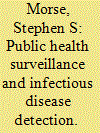|
|
|
Sort Order |
|
|
|
Items / Page
|
|
|
|
|
|
|
| Srl | Item |
| 1 |
ID:
126219


|
|
|
|
|
| Publication |
2012.
|
| Summary/Abstract |
Effective communication and coordination are critical when investigating a possible drinking water contamination incident. A contamination warning system is designed to detect water contamination by initiating a coordinated, effective response to mitigate significant public health and economic consequences. This article describes historical communication barriers during water contamination incidents and discusses how these barriers were overcome through the public health surveillance component of the Cincinnati Drinking Water Contamination Warning System, referred to as the "Cincinnati Pilot." By enhancing partnerships in the public health surveillance component of the Cincinnati Pilot, information silos that existed in each organization were replaced with interagency information depots that facilitated effective decision making.
|
|
|
|
|
|
|
|
|
|
|
|
|
|
|
|
| 2 |
ID:
126128


|
|
|
|
|
| Publication |
2012.
|
| Summary/Abstract |
Emerging infectious diseases, such as HIV/AIDS, SARS, and pandemic influenza, and the anthrax attacks of 2001, have demonstrated that we remain vulnerable to health threats caused by infectious diseases. The importance of strengthening global public health surveillance to provide early warning has been the primary recommendation of expert groups for at least the past 2 decades. However, despite improvements in the past decade, public health surveillance capabilities remain limited and fragmented, with uneven global coverage. Recent initiatives provide hope of addressing this issue, and new technological and conceptual advances could, for the first time, place capability for global surveillance within reach. Such advances include the revised International Health Regulations (IHR 2005) and the use of new data sources and methods to improve global coverage, sensitivity, and timeliness, which show promise for providing capabilities to extend and complement the existing infrastructure. One example is syndromic surveillance, using nontraditional and often automated data sources. Over the past 20 years, other initiatives, including ProMED-mail, GPHIN, and HealthMap, have demonstrated new mechanisms for acquiring surveillance data. In 2009 the U.S. Agency for International Development (USAID) began the Emerging Pandemic Threats (EPT) program, which includes the PREDICT project, to build global capacity for surveillance of novel infections that have pandemic potential (originating in wildlife and at the animal-human interface) and to develop a framework for risk assessment. Improved understanding of factors driving infectious disease emergence and new technological capabilities in modeling, diagnostics and pathogen identification, and communications, such as using the increasing global coverage of cellphones for public health surveillance, can further enhance global surveillance
|
|
|
|
|
|
|
|
|
|
|
|
|
|
|
|
|
|
|
|
|